Scientists and tourists saw the first total solar eclipse from the continent of Antarctica in over a century on Sunday. Because of its remote location, some people chose to fly in two airplanes that followed the path of the eclipse, while others waited on an icebreaker. Some people also saw the eclipse from a few of the scientific outposts on the continent that were under the path of totality. The point of the greatest eclipse only lasted for one minute, 55 seconds. The next total eclipse will be in April 2005, and only be visible from the middle of the Pacific Ocean.
Seeing a Star’s Final Moments
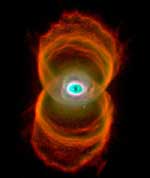
Image credit: Hubble
Although stars can burn for billions of years, their final stages can take a relatively short period of time. In many cases, it only takes a few hundred thousand years for dying stars to slough off their outer layers to create the familiar planetary nebula. Since they happen so quickly, they’re relatively rare to find, but astronomers think they’ve got a candidate with a relatively nearby star called V Hydra. The star is in its final stages, and jets of material have just begun emanating from it.
It takes only a few hundred to a thousand years for a dying Sun-like star, many billions of years old, to transform into a dazzling, glowing cloud called a planetary nebula. This relative blink in a long lifetime means that a Sun-like star’s final moments – the crucial phase when its planetary nebula takes shape – have, until now, gone undetected.
In research reported in the Nov. 20 issue of Nature, astronomers led by Dr. Raghvendra Sahai of NASA’s Jet Propulsion Laboratory, Pasadena, Calif., have caught one such dying star in the act. This nearby star, called V Hydrae, has been captured by the Space Telescope Imaging Spectrograph onboard NASA’s Hubble Space Telescope in the last stages of its demise, just as material has begun to shoot away from it in a high-speed jet outflow.
While previous studies have indicated the role of jet outflows in shaping planetary nebulae, the new findings represent the first time these jets have been directly detected.
“The discovery of a newly launched jet outflow is likely to have a significant impact on our understanding of this short-lived stage of stellar evolution and will open a window onto the ultimate fate of our Sun,” said Sahai.
Other institutions contributing to this paper include: University of California, Los Angeles; Princeton University, Princeton, New Jersey; Harvard-Smithsonian Center for Astrophysics, Cambridge, Massachusetts; and Valdosta State University, Valdosta, Georgia.
Low-mass stars like the Sun typically survive around ten billion years before their hydrogen fuel begins to run out and they start to die. Over the next ten to hundred thousand years, the stars slowly eject nearly half of their mass in expanding, spherical winds. Then – in a poorly understood phase lasting just 100 to 1,000 years – the stars evolve into a stunning array of geometrically shaped glowing clouds called planetary nebulae.
Just how these extraordinary “star-clouds” are shaped has remained unclear, though Sahai, in several previous papers, put forth a new hypothesis. Based on results from a recent Hubble Space Telescope imaging survey of young planetary nebulae, he proposed that two-sided, or bipolar, high-speed jet-like outflows are the primary means of shaping these objects. The latest study will allow Sahai and his colleagues to test this hypothesis with direct data for the first time.
“Now, in the case of V Hydrae, we can observe the evolution of the jet outflow in real-time,” said Sahai, who together with his colleagues will study the star with the Hubble Space Telescope for three more years.
The new findings also suggest what may be driving the jet outflows. Past models of dying stars predict that accretion discs – swirling rings of matter encircling stars – may trigger jet outflows. The V Hydrae data support the presence of an accretion disc surrounding, not V Hydrae itself, but a companion object around the star. This companion is likely to be another star or even a giant planet too dim to be detected. The authors have also found evidence for an outlying large dense disc in V Hydrae, which could enable the formation of the accretion disc around the companion.
Further support in favor of a companion-driven jet outflow comes from the scientists’ observation that the jet fires in bursts: because the companion orbits the star in a periodic fashion, the accretion disc around it is expected to produce regular spurts of material rather than a steady stream.
The Space Telescope Imaging Spectrograph is managed by NASA’s Goddard Space Flight Center in Greenbelt, Maryland. The Hubble Space Telescope is a project of international cooperation between NASA and the European Space Agency. The California Institute of Technology, Pasadena manages JPL for NASA.
Original Source: NASA/JPL News Release
Cheap Method for Finding Extrasolar Planets
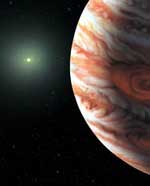
Image credit: ESA
Astronomers from the University of Texas at Austin believe they’ve figured out an inexpensive way to search for extrasolar planets. After stars like our own Sun use up their fuel they eventually turn into red giant stars, and then shrink again to become white dwarfs. Although the process will likely destroy the inner planets, the outer planets will probably still remain in orbit around the star. These white dwarfs are known to pulsate at a specific rate, so the gravity of a planet moving around the star should affect this pulse rate by a minute amount that should be detectable by inexpensive Earth-based telescopes.
University of Texas at Austin astronomers have invented an inexpensive method to determine if other solar systems like our own exist.
Among the more than 100 stars now known to have planets, astronomers have found few systems similar to ours. It?s unknown if this is because of technological limitations or if our system is truly a rare configuration. The McDonald Observatory astronomers? novel search method uses a Depression-era telescope mated with today?s technology.
Astronomers Don Winget and Edward Nather, graduate students Fergal Mullally and Anjum Mukadem, and colleagues are looking for the “leftovers” of solar systems like ours. Their method searches for the pieces of such a solar system after its star has died, by exploiting a trait of ancient, burnt-out Suns called “white dwarfs.”
University of Texas astronomers Bill Cochran and Ted von Hippel are also involved, along with S.O. Kepler of Brazil?s Universidade Federal de Rio Grande dol Sul and Antonio Kanaan of Brazil?s Universidade Federal de Santa Catarina.
Astronomers know that as Sun-like stars use up their nuclear fuel, their outer layers will expand, and the star will become a “red giant” star. When this happens to the Sun, in about five billion years, they expect it will swallow Mercury and Venus, perhaps not quite reaching Earth. Then the Sun will blow off its outer layers and will exist for a few thousand years as a beautiful, wispy planetary nebula. The Sun?s leftover core will then be a white dwarf, a dense, dimming cinder about the size of Earth. And, most important, it likely will still be orbited by the outer planets of our solar system.
Once a Sun-like system reaches this state, Winget?s team may be able to find it. Their method is based on more than three decades of research on the variability (that is, changes in brightness) of white dwarfs. In the early 1980s, University of Texas astronomers discovered that some white dwarfs vary, or “pulsate,” in regular bursts. More recently, Winget and colleagues discovered that about one-third of these pulsating white dwarfs (PWDs) are more reliable timekeepers than atomic clocks and most millisecond pulsars.
These pulsations are the key to detecting planets. Planets orbiting a stable PWD star will affect observations of its timekeeping, appearing to cause periodic variations in the patterns of pulses coming from the star. That?s because the planet orbiting the PWD drags the star around as it moves. The change in distance between the star and Earth will change the amount of time taken for the light from the pulsations to reach Earth. Because the pulses are very stable, astronomers can calculate the difference between the observed and expected arrival time of the pulses and deduce the presence and properties of the planet. (This method is similar to that used in the discoveries of the so-called “pulsar planets.” The difference is, the pulsar companions are not thought to have formed with their stars, but only after those stars had exploded in supernovae.)
“This search will be sensitive to white dwarfs which were initially between one and four times as massive as the Sun, and should be able to detect planets within two to 20 AU from their parent star. This means we?ll be probing inside the habitable zone for some stars,” Winget said. (An AU, or astronomical unit, is the distance between Earth and the Sun.) “Basically, detecting Jupiter at Jupiter?s distance with this technique is easy. It?s duck soup,” he said.
Easy, but not quick. Outer planets, orbiting their stars at large distances, can take more than a decade to complete one orbit. Therefore, it can take many years of observations to definitively detect a planet orbiting a white dwarf.
“You need to look for a long time for a full orbit,” Winget said. “A half-orbit or a third of an orbit will tell us something?s going on there. But for a planet at Jupiter?s distance, a half-orbit is still six years.” Winget added that for this method, “detecting Jupiter at Uranus? distance is easier, but takes even longer.”
For the PWD planet search, Nather conceived a specialized new instrument for McDonald Observatory?s 2.1-meter Otto Struve Telescope. He and Mukadam designed and built the instrument, called Argos, to measure the amount of light coming from target stars. Specifically, Argos is a “CCD photometer” ? a photon counter that uses a charge-coupled device to record images. Located at the prime focus of the Struve Telescope, Argos has no optics other than the telescope?s 2.1-meter primary mirror. Copies of Argos are now being built at other observatories around the world.
Mullally continues the search for planets around white dwarfs with Argos on the Struve Telescope. He has 22 target stars, most of which were identified through the Sloan Digital Sky Survey. When the team finds promising planet candidates with Argos, they will follow up using the 9.2-meter Hobby-Eberly Telescope (HET) at McDonald Observatory.
“If we find large planets orbiting at large distances, that?s a good clue that there might be smaller planets closer in. In that case, what you do is pound away on that target with the largest telescope you have access to,” Winget said. The HET will enable more precise timing of the PWD?s pulses, and thus be able to pinpoint smaller planets.
This search will be able to study types of stars unable to be studied with the doppler spectroscopy method ? the most successful planet search method to date ? Winget said. Because of idiosyncrasies in the make-up of Sun-like stars, the doppler spectroscopy method is not very sensitive in looking for planets around stars twice as massive as the Sun. Roughly half of the stars in Winget?s study will be white dwarfs that were originally these types of stars. For this reason, the PWD study at McDonald can be instrumental in scouting and assessing targets and observing strategies for NASA space missions planned in the next two decades, specifically the Space Interferometry Mission, Terrestrial Planet Finder and Kepler spacecraft.
This research is funded by a NASA Origins grant, as well as an Advanced Research Project grant from the State of Texas. Through funding from the Texas Higher Education Agency, two secondary schoolteachers (Donna Slaughter of Stony Point High School in Round Rock, Texas, and Chris Cotter of Lanier High School in Austin) have been directly involved in this research. Plans are now underway to extend this involvement to other teachers, and the students in their classrooms by bringing the science, scientists and the Observatory directly into the classroom using the Internet. Cotter and his colleagues at Lanier High School are involved with Mullally in testing this concept.
Original Source: McDonald Observatory News Release
Next Station Crew Announced
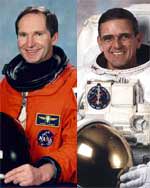
Image credit: NASA
NASA has announced the next crew to inhabit the International Space Station: NASA astronaut William S. McArthur Jr and Russian cosmonaut Valery I. Tokarev. Designated Expedition 9, the two men will be launched to the station some time in April 2004 on board a Soyuz rocket from the Baikonur cosmodrome in Kazakhstan. European Space Agency astronaut Andre Kuipers will also join them for the trip and stay on the station for a week before returning with the crew of Expedition 8. McArthur has flown on three shuttle flights, and Tokarev has been on one shuttle flight.
Veteran NASA astronaut William S. McArthur Jr., a retired U.S. Army colonel, and Russian Air Force Colonel Valery I. Tokarev are the next crew for the International Space Station.
McArthur and Tokarev trained as backups for the current Station crew. They will launch to the Station aboard a Russian Soyuz spacecraft in April 2004. Their six-month mission is designated Expedition 9. McArthur will serve as Station Commander and NASA Space Station Science Officer. Tokarev is the Soyuz Commander and Station Flight Engineer. During their stay aboard the orbiting research laboratory, the crew will conduct scientific studies in Earth sciences, life sciences, fundamental biology and microgravity.
European Space Agency (ESA) Astronaut Andre Kuipers joins McArthur and Tokarev on their Soyuz flight. He will spend eight days aboard the Station conducting experiments under a commercial agreement between ESA and the Russian Aviation and Space Agency. Kuipers returns to Earth with Expedition 8 Commander Mike Foale and Soyuz Commander Alexander Kaleri. Kuipers’ backup for the flight is ESA Astronaut Gerhard Thiele.
McArthur flew on three Shuttle missions: STS-58 in 1993; STS-74 in 1995; and STS-92, a Station assembly flight, in 2000. Tokarev first flew in 1999 aboard STS-96. The backup crew for Expedition 9 is veteran NASA astronaut Leroy Chiao, Ph.D., and Russian cosmonaut Salizhan S. Sharipov. Chiao was a Mission Specialist aboard STS-65 in 1994; STS-72 in 1996; and STS-92 in 2000. Sharipov was a Mission Specialist on STS-89 in 1998.
Original Source: NASA News Release
Galactic Wind Connects Galaxies
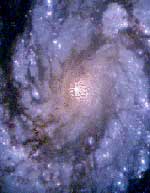
Image credit: Hubble
Astronomers have known for nearly a century that galaxies are distinct islands of stars, floating apart from each other in space. But it turns out that galaxies are more connected than previously believed because of large-scale “galactic winds” which blow off of galaxies and interact with each other. Researchers from the University of Maryland studied galactic winds in both visible and X-ray light around 10 galaxies, and found that they can often fill an area larger than the galaxy itself. This wind is thought to come from stars and actively feeding black holes.
It was the 17th Century English preacher and poet John Donne who wrote the immortal lines “No man is an island, entire of itself; every man is a piece of the continent, a part of the main.”
Today, astronomers have determined we also do not live in an “island Universe” – that is, a Universe in which the vast agglomerations of gas and stars known as galaxies are wholly independent of the influence of neighboring galaxies and their surrounding environment. Sylvain Veilleux, an astronomer at the University of Maryland, and his colleagues have found important new evidence to support the connectedness of galaxies in the form of unexpectedly large-scale “galactic winds” blowing off of galaxies, altering their surroundings out to distances much farther than previously thought. Galactic winds are the streams of charged particles that blow off of galaxies.
“We are seeing that these galactic winds are blowing off of galaxies on a very large scale,” said Veilleux. “We have detected these winds in both visible light and X-ray light on scales that are sometimes much larger than the galaxies themselves.” The findings are published in the November 2003 issue of the Astronomical Journal, Vol. 126 No. 5 (http://www.journals.uchicago.edu/AJ/journal/issues/v126n5/203224/203224.html). Veilleux’s colleagues in this study were David S. Rupke, a graduate student in physics at the University of Maryland, Patrick L. Shopbell of the California Institute of Technology, Jonathan Bland-Hawthorn of the Anglo-Australian Observatory in Australia, and Gerald N. Cecil of the University of North Carolina at Chapel Hill.
Based on data from the Chandra X-ray Observatory, the Anglo-Australian Observatory located near Coonabarabran in Australia, and the William Herschel Telescope on La Palma in the Canary Islands, Veilleux said these findings have important consequences for the evolution of galaxies and their environment. Veilleux and his colleagues examined the galactic winds surrounding 10 galaxies. Located between 20 and 900 million light years from Earth, the galaxies are in different galaxy clusters and none are in our Milky Way Galaxy’s Local Group cluster. But Veilleux, who is presently on sabbatical at the California Institute of Technology, believes the findings hold for the Milky Way’s galactic wind as well. Galactic winds result from two sources: stars and actively feeding (accreting) giant black holes lurking at the centers of most galaxies. In the first case, Veilleux said, the winds are primarily produced by a combination of the stellar winds blowing off massive stars during their youth and by the titanic explosions known as supernovae that mark their death. Winds produced by these stars are referred to as “starburst-driven.” Starbursts are periods during which large numbers of massive stars are created. These, periods of star creation, in turn, produce strong stellar winds. These massive stars eventually die as supernova. In the second case, he said, enormous (supermassive) and active black holes lurking in the hearts of their host galaxies generate galactic winds. “An ‘active’ black hole is one that is accreting or pulling in a significant amount of the material that is available to it,” Veilleux said. “Such black holes are called ‘active galactic nuclei’ or AGN and the winds they produce are referred to as AGN-driven.”
The Milky Way’s central black hole is an inactive or dormant black hole simply because there isn’t much material in its vicinity available for it to accrete. Measuring the Galactic Wind Veilleux said astronomers are able to detect galactic winds because of the energy emitted when particles that make up the wind collide with other particles. “We can detect these galactic winds because collisions among the charged particles create electromagnetic energy emissions in the form of X rays, visible light and radio waves,” he explained. “These emissions are not uniform in the regions around the galaxies. Rather, they are clumpy, being most notable in the regions where hot gas in the wind collides with colder material from the galaxies themselves or from the intergalactic medium.” The result is filaments of emissions surrounding galaxies in irregular bubble-shaped regions out to at least 65,000 light years from the galaxy centers. Veilleux and his colleagues compared existing Chandra X-ray data with new ground-based observations obtained with a special tunable filter on the Anglo-Australian telescope, which permitted the detection of optical emission down to unprecedented brightness levels. They found the clumpy filaments correlated quite well. This, they say, indicates that galactic winds are indeed influencing the surrounding inter-galactic environment out to previously unknown distances. A Role in the Evolution Galaxies? “What we found is that these winds have a very large zone of influence and probably a strong impact not only on the host galaxy but also on scales in excess of 65,000 light years, possibly well out into the intergalactic medium,” Veilleux said.
Veilleux said the findings mean any comprehensive understanding of long-term galaxy evolution must take into account the flow of gaseous material out of, and back into, the galaxy.
“Galactic winds move at between about 300 and 3000 kilometers per second and if they don’t have enough speed to escape the gravitational pull of the galaxy entirely, it means the material in them would rain back down on the galactic halo and even the disk,” he said. Veilleux explained that such a return “rain” would contribute to the re-enrichment of the host galaxy itself and in this way the more massive galaxies would be able to keep their heavier metals (the sort forged by massive stars during their lives and deaths in supernovae). “The whole issue of the flow of warm gas back into galaxies is very important to understanding the rate at which new stars form.” As for the implications to the Milky Way, Veilleux said the findings for these far away galaxies suggest our Galaxy has its own galactic wind that is creating large-scale bubbles of material around it. Previous findings for the Milky Way have shown direct evidence for a galactic-scale wind at a variety of wavelengths. It is unclear if the Milky Way’s wind is interacting with the nearby Sagittarius dwarf galaxy, which astronomers have discovered is being assimilated into our galaxy through tidal (gravitational) forces. However, Veilleux’s findings have established that galaxies do indeed interact with their surroundings in important ways. “As a result of findings such as these, we now know the closed box or ‘island Universe’ view is not true,” he said.
Original Source: University of Maryland
Canadian Arrow’s Engine Tested
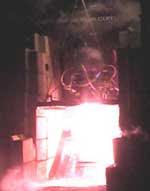
Image credit: Canadian Arrow
The Canadian Arrow X-Prize team has performed a successful low-pressure test of their liquid oxygen and ethyl alcohol rocket engine, bringing them one step closer to winning the $10 million X-Prize. The Canadian Arrow is based on the design of a World War II German V-2 rocket, but it’s been updated with modern technology. The team has scheduled several more tests of the rocket engine at higher pressures, and hopes to make an actual launch attempt some time in 2004.
The Canadian Arrow X PRIZE Team has successfully tested the rocket engine that is designed to, in the coming months, take passengers into space.
The test, conducted late last evening at a test site north of London confirms that the Canadian Arrow Team has successfully reengineered a World War II rocket design into a modern technology that is capable of winning the $10 million X PRIZE.
“Our team has spent five years researching, designing and building toward the test we performed tonight,” said Canadian Arrow Team Leader Geoff Sheerin. “We had a perfect ignition and good clean burn. There were a lot of smiles here, that’s for sure.”
The engine, with 57,000 pounds of thrust, is modeled after the German V-2 rocket engine and is believed to be the largest liquid propellant engine ever built in Canada. It is fueled by a mixture of liquid oxygen and ethyl alcohol and at full pressure, consumes approximately 250 pounds of propellant per second. Last night’s test was at partial pressure, and opens the door to higher pressure testing.
The engine and test stand are part of a 45 ft. tall structure that is surrounded on three sides by concrete walls that are two feet thick. Large berms stand between the engine test structure and the control centre that is built into the ground, and is where the team electronically directed and monitored the test.
“This has taken us a bold leap closer to our flights that will capture the X PRIZE,” said Sheerin. “It wasn’t just a test of our engine, but of our test stand, support equipment, team capabilities and many other things that will be necessary to support full launch capabilities.”
Next steps for the team will include continued testing of the engine to prepare it for actual flight onboard the first Canadian Arrow spacecraft that is scheduled for launch next year. When successful, the Arrow will make Canada the fourth nation to put humans into space.
Sheerin thanked his Team for their long hours and dedication. “Most importantly,” he told them, “we have taken the next step toward our stated goal of ‘making space for you.’
Original Source: Canadian Arrow News Release
Auroras in Scotland
Hey everyone, I just got an email from Robert Law at the Mills Observatory that he’s seeing auroras in sky above Scotland which are as spectacular as those many of you saw a few weeks ago. This is no guarantee, but if your skies are clear, maybe you’ll see an aurora too. While you’re at it, there’s still a chance to see some of the Leonid meteors.
Let me know if you have any luck. Send me an email at [email protected].
Good luck!
Fraser Cain
Publisher
Universe Today
Book Review: A Traveler’s Guide to Mars
Over the last few hundred years, humans have been exploring the planet Mars – first through telescopes, and more recently from orbit and on the ground. During this time we’ve gone from complete ignorance to a fairly deep understanding of the Red Planet. William K. Hartmann has been a scientist on several missions to Mars, and in his latest book, “A Traveler’s Guide to Mars,” he details our current understanding of the geologic process that have shaped the planet.
Over the last few hundred years, humans have been exploring the planet Mars – first through telescopes, and more recently from orbit and on the ground. During this time we’ve gone from complete ignorance to a fairly deep understanding of the Red Planet. William K. Hartmann has been a scientist on several missions to Mars, and in his latest book, “A Traveler’s Guide to Mars,” he details our current understanding of the geologic process that have shaped the planet.
First, a little history about William Hartmann. He cut his Martian teeth as a scientist on the Mariner 9 mission, which was the first spacecraft to map Mars in detail. He was part of the team that discovered craters, ancient riverbeds and volcanoes. He was an early contributor to the widely accepted theory that the Moon formed when a Mars-sized planet crashed into the Earth. And he’s currently studying the data retrieved by the Mars Global Surveyor.
This guy knows his Mars.
“A Traveler’s Guide to Mars” traces our understanding of Mars, starting with the early sketches by Huygens and Percival Lowell (who incorrectly thought that Martians had built a complex system of canals to conserve the planet’s water). When Mariner 9 arrived at Mars in the early 1970s, it complete revised our understanding of the planet, showing that it was dry and pummeled with ancient asteroid impact craters. The history section of the book is pretty short.
The bulk of the book explores the planet, feature by feature, and describes how planetary scientists arrived at their current understanding about what’s going on. Scientists believe certain areas of Mars are unchanged for 4.5 billion years, while others have been under constant change until recently. Hartmann presents the evidence and shows you how to spot the clues and think like a planetary scientist.
I think this is one of my favorite aspects of the book. Time after time Hartmann presents the challenge: what caused this formation? what’s going on in this crater? how long was this river flowing? And then he presents the evidence and the decision-making process that planetary scientists followed to arrive at their current conclusions. And if nobody has a clue, he admits that too. There are plenty of mysteries left on Mars – hopefully new spacecraft and missions to Mars will help fill in pieces of the puzzle.
The book is broken up with one/two-page sections called “My Martian Chronicles”, which detail Hartmann’s personal experiences exploring Mars through the eyes of Mariner 9 and Mars Global Surveyor. I really enjoyed this personal touch. Since Hartmann is an experienced fiction writer, his style is very casual and accessible. Easy reading for the amateur space enthusiast.
I was really impressed with “A Traveler’s Guide to Mars”. It’s given me a new understanding of the planet. Definitely a handy book to have on hand as a new fleet of spacecraft are about to arrive at the Red Planet.
More information from Amazon.com – Amazon.ca – Amazon.co.uk
Update on the Mars Rovers
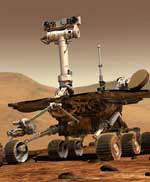
Image credit: NASA/JPL
In case you’d forgotten about them, NASA’s twin Mars Exploration spacecraft, Spirit and Opportunity, are still on their way to the Red Planet. Spirit made its third trajectory correction last week to fine-tune its flight path as it gets closer. Both rovers have rebooted their computers in the past two weeks to remove any data errors that could have caused by the recent powerful solar storms. Spirit should arrive at the Gusev Crater on January 4, 2004, while Opportunity will land Meridiani Planum on January 25.
NASA’s Spirit spacecraft made its third trajectory correction maneuver on Friday, Nov. 14, fine tuning its flight path toward Mars with an engine-firing operation planned into the seven-month trip.
The trajectory adjustment was designed to alter Spirit’s velocity by 0.6 meters per second (1.3 miles per hour), moving the arrival point by 770 kilometers (478 miles) and arrival time by 16.5 minutes closer to the planned target location and time, said Louis D’Amario, the project’s navigation team chief. To accomplish that adjustment, the flight team commanded Spirit to fire its engines for 132 seconds in the direction of the spacecraft’s rotation axis and for short pulses totaling 27 seconds in a direction roughly perpendicular to the rotation axis.
Spirit has three more scheduled dates for additional trajectory corrections before reaching Mars less than seven weeks from now. The spacecraft is carrying the first of two Mars Exploration Rovers equipped to examine the geology around their landing sites for evidence about past environmental conditions.
Both Spirit and its twin, Opportunity, have rebooted their computers in the past two weeks. Mission controllers at NASA’s Jet Propulsion Laboratory, Pasadena, Calif., sent commands for that procedure on each spacecraft to correct possible corruption of computer memory registers by radiation from powerful solar flares in late October and early November. The flares were among the most intense ever recorded.
“We had no evidence of memory problems, but we considered it prudent to reboot both spacecraft to assure memory integrity, using the sleep-wake cycle that we plan to do each night after the rovers are on the surface of Mars,” said JPL’s Peter Theisinger, project manager for the Mars Exploration Rover Project.
High-energy protons ejected by the stormy Sun appeared on Oct. 28 as bursts of bright spots in star-tracking instruments used by both Spirit and Opportunity to sense the spacecrafts’ orientation. The instruments interpreted the proton hits as stars, so the bursts overwhelmed their ability to recognize star patterns and determine spacecraft attitude. Both spacecraft temporarily switched to a backup method of attitude sensing, using the Sun. They resumed use of the star trackers last week.
Spirit’s target is arrival at Mars’ Gusev Crater at 04:35 Jan. 4, 2004, Universal Time (8:35 p.m. Jan. 3, Pacific Standard Time and 11:35 p.m. Jan. 3, Eastern Standard Time). These are “Earth received times,” meaning they reflect the delay necessary for a speed-of-light signal from Mars to reach Earth; on Mars, the landing will have happened nearly 10 minutes earlier. Three weeks later, at 05:05 Jan. 25, Universal Time, Opportunity will arrive at a level plain called Meridiani Planum on the opposite side of Mars from Gusev. Each rover will examine its landing area for geological evidence about the history of water there, key information for assessing whether the site ever could have been hospitable to life.
As of 6 a.m. PST on Nov. 19, Spirit had traveled 396.5 million kilometers (246.4 million miles) since its June 10 launch, with 91.5 million kilometers (56.2 million miles) to go before reaching Mars. Opportunity, launched on July 7, had traveled 326 million kilometers (202 million miles) and has 130 million kilometers (81 million miles) yet to go.
JPL, a division of the California Institute of Technology, manages the Mars Exploration Rover project for NASA’s Office of Space Science, Washington, D.C. Additional information about the project is available from JPL at http://mars.jpl.nasa.gov/mer and from Cornell University, Ithaca, N.Y., at http://athena.cornell.edu.
Original Source: NASA/JPL News Release
Station in Orbit for Five Years
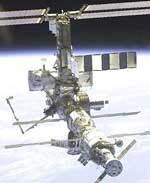
Image credit: NASA
The International Space Station has been in orbit for five years as of November 20, 2003. The first element of the station, the Russian Zarya control module, was launched on November 20, 1998, and then quickly followed up by the US-built Unity module. Since then, the station has orbited the Earth 29,000 times and has been inhabited since November 2, 2000. Eight successive crews, 22 people, have staffed the station and performed research in bioastronautics, physical sciences, fundamental space biology, space product development and space flight disciplines. Happy birthday ISS.
The International Space Station reaches the historic five years in space milestone on November 20, 2003. The unique orbiting laboratory complex has grown from a lone, uninhabited module into a permanently staffed, house-sized research facility.
The Station remains the largest and most complex international space research project in history. The Station will eventually triple scientific capacity with components awaiting the Space Shuttle’s return to flight.
The first Space Station element, the Russian Zarya control module, was launched from Baikonur, Kazakhstan, Nov. 20, 1998. Two weeks later, the Space Shuttle Endeavour delivered the second element, the U.S. connecting module called Unity. The challenges, triumphs and tragedy shared by the international partnership since then have solidified cooperation on the Station among the United States, Russia, Canada, Japan and Europe.
“Together with our international partners we have learned how to build, operate and maintain a very complex spacecraft, through the good times and the bad,” said Bill Gerstenmaier, NASA Space Station Program Manager. “With this experience to guide us, we look forward to the future, with a vast expansion of the Station on the horizon.”
At five years old, the Station is still growing. More than 80 tons of equipment and hardware are in the Space Station Processing Facility at NASA’s Kennedy Space Center (KSC), Fla. being prepared for launch.
The Space Station has orbited the Earth more than 29,000 times. It is visible in the night sky as it flies more than 210 miles overhead. The living and working area inside the Station has a volume of about 15,000 cubic feet, larger than a three-bedroom house.
The orbiting complex has been inhabited since Nov. 2, 2000. Eight successive crews, 22 people, have staffed the Station. Residents have conducted research in bioastronautics, physical sciences, fundamental space biology, space product development and space flight disciplines. In the U.S. Destiny Lab alone, astronauts have worked on over 70 different science experiments.
Hundreds of people on Earth support Station operations from the Station Mission Control Center at NASA’s Johnson Space Center in Houston. Round-the-clock science operations are handled by the Payload Operations Center team at NASA’s Marshall Space Flight Center in Huntsville, Ala. Hundreds of other scientists and engineers perform important jobs, such as training Station crews and building new hardware that will become part of the orbiting laboratory.
Additional research facilities are being readied for launch on future Shuttle missions. They will enhance Destiny’s capabilities in the areas of fundamental space biology; glass and porous ceramics materials processing research; human physiology research; combustion research; research on the behavior of fluids; Earth observations; and experiment refrigerator/freezer conditioned sample storage.
Also awaiting launch at KSC are solar arrays and support structures that will triple the sunlight-gathering, solar cell area, thereby increasing the power dedicated to research by 84 percent.
The Node 2 module that will serve as a connector between the U.S., European and Japanese research labs is at KSC undergoing pre-launch processing. The Kibo Japanese Experiment Module, including a pressurized lab already at KSC, will also be added to the Station. The European Columbus Laboratory, under construction in Bremen, Germany, will expand the Station’s volume to almost that of a five-bedroom house.
For information about NASA, human spaceflight, astronauts, and the International Space Station on the Internet, visit:
Original Source: NASA News Release
